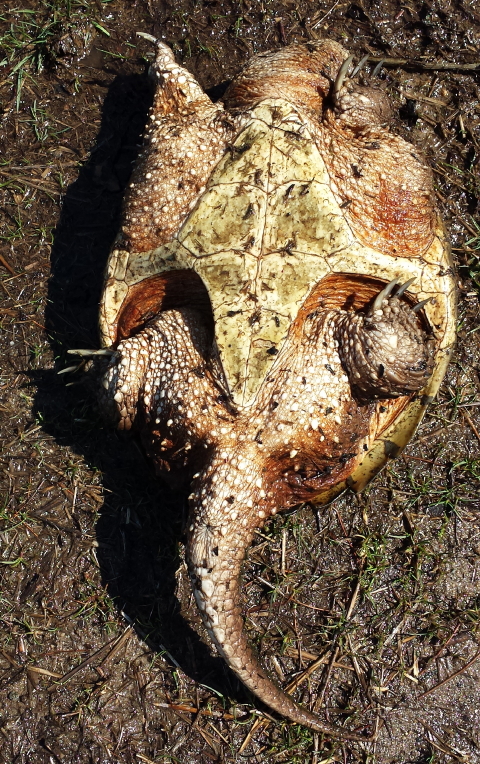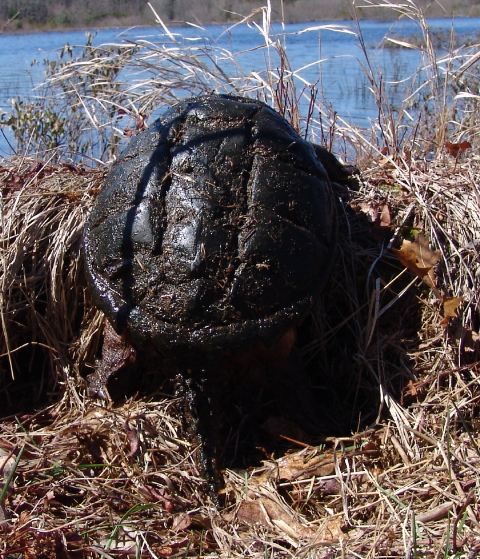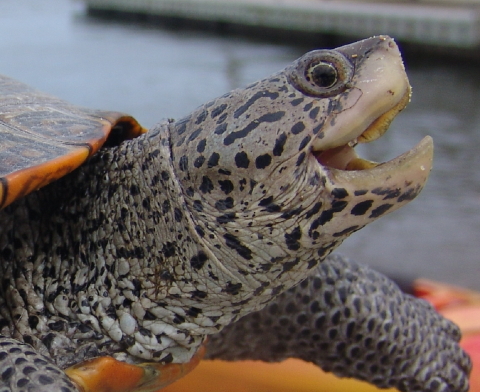Sue Wieber Nourse Examines Four Spotted Turtles on Easter
Temperatures dipped below freezing on Easter morning on the SouthCoast of Massachusetts. Â Cold brought quiet to spring activity in local wetlands with a single, lazing garter snake and a pair of spotted turtles our only observations in protected Goldwitz Bog.
Garter Snake at SouthCoast Bog
The young garter snake had sprawled out on the sunny pathway at the abandoned Goldwitz bog and seemed unamused when Turtle Journal’s Don Lewis pulled out his smart phone to snap a few closeups.
Female (Left) and Male (Right) Spotted Turtles
Turtle Journal’s Sue Wieber Nourse found female Spotted Turtle #53 (on the left) relaxing with male Spotted Turtle #118 (on the right). Â Pictured above, they represent perfect gender types: Â she with her colorful neck and thin tail; he with his drab neck and thick tail. Â Male #118 also exhibits concavity across his plastron’s abdominal scutes, while Female #53 shows off her flat, washboard abs. Â They, too, were found in a degraded mating aggregation at Goldwitz bog.
Male Spotted Turtle #120
About a mile away the Turtle Journal team explored the Grassi Bog around noon on Easter as temperatures climbed into the mid-50s. Â At this wetlands we discovered spotted turtles in full mating glory. Â Seen above is male Spotted Turtle #120. Â He hit the scales at 188 grams (6.6 ounces) and his carapace (top shell) measured 11.43 centimeters (4.5 inches). Â For our spotted turtles, he’s a very big boy!
Female Spotted Turtle #121
We also netted female Spotted Turtle #121, an 11-year-old that weighed 185 grams (6.5 ounces). Â Her shell length measured 10.56 centimeters (4.2 inches).
Female Spotted Turtle #122
Female Spotted Turtle #122 is only nine years old. Â She weighed 115 grams (4.1 ounces) and measured 9.61 centimeters (3.8 inches).
Young Five-Year-Old Female Spotted Turtle #123
The real sweetheart of the bunch is young Spotted Turtle #123, a five year old female. Â She only registered 64 grams (2.3 ounces). Â Her carapace (top shell) measured a mere 7.18 centimeters (2.8 inches).
Sue Wieber Nourse Release Spotted Turtles
After we examined the turtles and took scientific measurements, Sue Wieber Nourse released the spotted turtles back into Grassi Bog.
Two-Year-Old Painted Turtle
The Turtle Journal team also found a juvenile (2-year-old) painted turtle basking in some brambles at Grassi Bog. Â No Easter bouquet could be complete without a baby painted turtle to add a dash of color to the day.



























